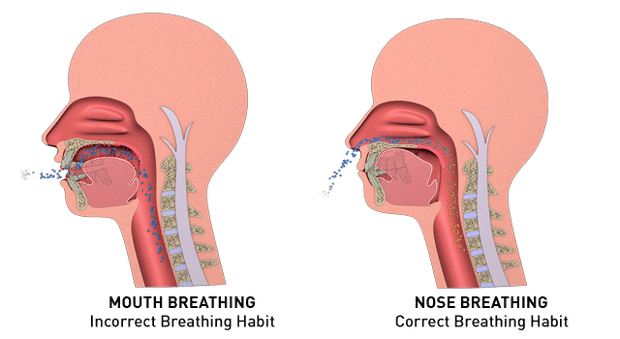 We all know that breathing is central to life. So it’s not surprising that a chronic stuffy nose — or any obstruction that prevent you from breathing optimally – is more than just uncomfortable for you – it can actually cause health problems that will last a lifetime. And many of us have put up with obstructive breathing for years – even decades!
We all know that breathing is central to life. So it’s not surprising that a chronic stuffy nose — or any obstruction that prevent you from breathing optimally – is more than just uncomfortable for you – it can actually cause health problems that will last a lifetime. And many of us have put up with obstructive breathing for years – even decades!
Fortunately, your dentist can help you breathe better and feel healthier. Using a comprehensive approach to dentistry, you can experience relief of you or your child’s symptoms in less time than you may think.
The basics. Optimum function of your respiratory system involves inhaling using the large muscle (diaphragm) at the base of your chest cavity, and drawing air in through your nose. Your nose has an important function in filtering, warming and humidifying the incoming air so that your lungs receive only clean, warm, moist air. This ensures that your body does not have to waste needless energy removing toxins from the lungs, as well as ensuring that critical delicate lung tissue is not traumatized or damaged.
Unlike most other tissues in the body, the lungs lack the ability to repair and rejuvenate themselves. Therefore, breathing through your nose is critical to the health of your lungs and, as a result, the functioning of your entire body. Loss of the ability to breathe through your nose can have a devastating long-term effect!
Symptoms and diagnosis. As part of your dental intake questionnaire and exam, your nasal breathing ability will be assessed. Due to environmental stresses (see TMJD), loss of healthy nasal breathing (partial or complete) is seen in greater numbers among the very young as well as in adults. One of the most common forms of this problem is seen in the phenomena of what is commonly referred to as Obstructive Sleep Apnea (OSA) – a condition where the tongue and palate collapse reducing oxygen supply to the vital organs, especially the brain.
In general, poor nasal breathing leads to mouth breathing – especially at night while sleeping. This often times leads to intermittent snoring and in some cases OSA. The vast majority of OSA cases are caused by the inability to breathe through the nose.
Sleep labs have sprung up all over the U.S. to assess and treat this disorder. As the level of carbon dioxide rises and oxygen falls in the blood, sensors in the blood vessel walls send off an alarm to the brain forcing the brain out of deep sleep. This action restores breathing but stresses the adrenal glands, robs the brain of deep recuperative sleep, elevates blood pressure and stresses the heart. In the adult, this process can and will shorten life span at the most and, at the very least, will cause extreme fatigue and accentuation of fatigue-related syndromes like fibromyalgia and other musculoskeletal disorders (see TMJD).
In children, reduced oxygen at night can seriously affect brain development at its extreme, and/or cause other related symptoms.
Symptoms and signs of poor nasorespiratory function in children:
– Snoring with possible OSA – Daytime fatigue
ADD/ADHD – Impaired school performance – Irritability
- Enuresis (bedwetting)
Orthodontic/ facial orthopedic disorders (see Orthodontics)
Deviated septum
- Poor posture, which perpetuates poor breathing and stress on the shoulders, back and hips
Poor exercise stamina – Reduced mental capacity – Chronic ear infections, colds, flu – Bruxism (grinding and clenching of teeth – especially at night)
Increased incidence of headaches, neck aches – Hypertension (seen only in the most extreme cases) – Increased dental gum irritation & dental decay
Symptoms and signs of poor nasorespiratory function in adults: Adults may experience all of what a child experiences with the exception of enuresis (bedwetting) and ear infections. In addition, adults who frequently experience the effects of long-term nasaorespiratory obstruction may also experience a magnification of musculoskeletal disorders, requiring increased dependency on therapists (chiropractors, physical therapists, cranio-sacral therapists, primary care physicians, alternative practitioners, etc.). Exacerbation of Fibromyalgia and TMJD is also common, and the kind of stress to the cardiovascular system that OSA causes is very serious and will ultimately lead to premature death.
Treatment options. The key to treatment is recognition of the problem. Screening by your dentist is performed along with possible X-rays and studies of the nasal passages to determine the nature of the obstruction. Potential referral to an ear, nose and throat specialist, allergist, or integrative physician may be the first step in treatment.
It is important to understand that this disorder in growing children can have a profoundly negative effect on facial growth and development (see Orthodontics). Early correction is recommended as soon as it is detected, as delay may result in irreversible alteration in the growth of the jaws that can only be resolved using radical therapies later in life that have poor chances of success.
Management of OSA in the adult is most successful when proper nasal respiratory function is improved. Conventional treatments include CPAP (a machine that forces air through the nose while sleeping) and, in extreme cases, a surgical procedure to remove the palate and some of the associated soft tissue structures.
Our goal is to treat you with a therapy that is not only effective, but will eliminate the need for invasive medical procedures. A viable alternative to these conventional treatments is the use of an oral orthotic (a specially designed “mouthguard” or sleep appliance), which when worn opens the airway during sleep. Not everyone that has OSA is a good candidate for such therapy. We can perform a specific dental examination to determine if you’re a candidate for an oral orthotic.
